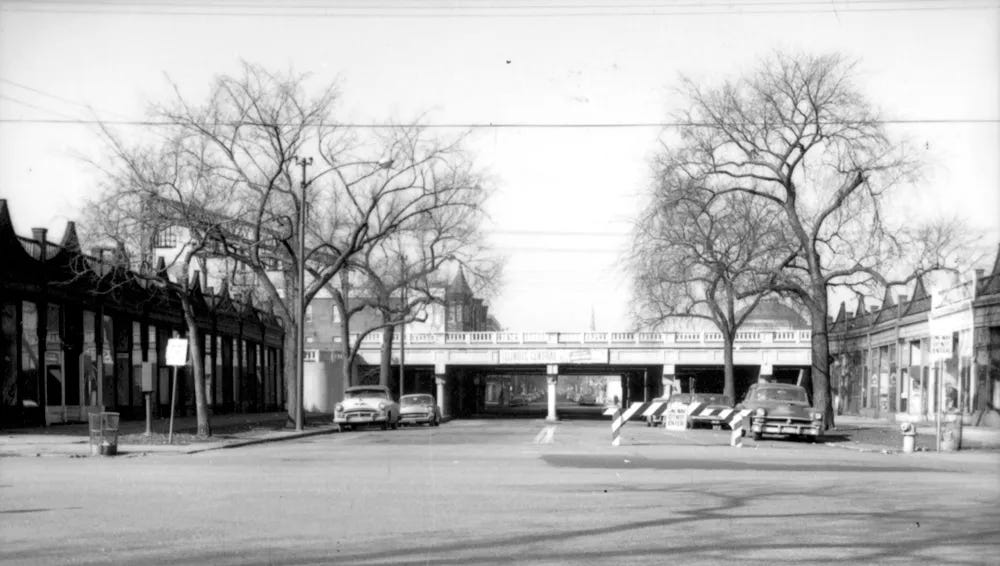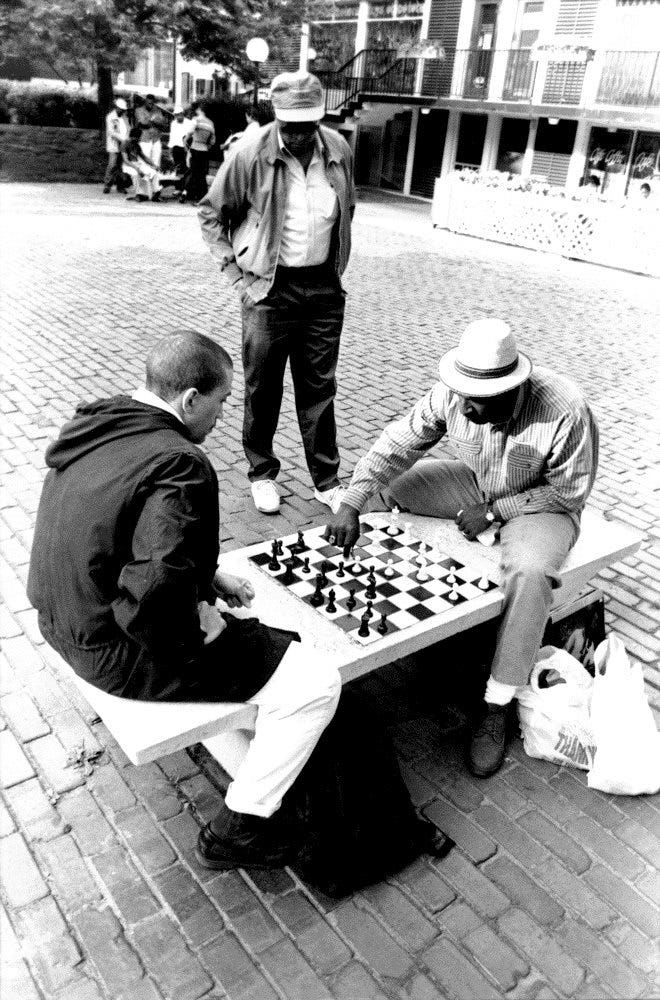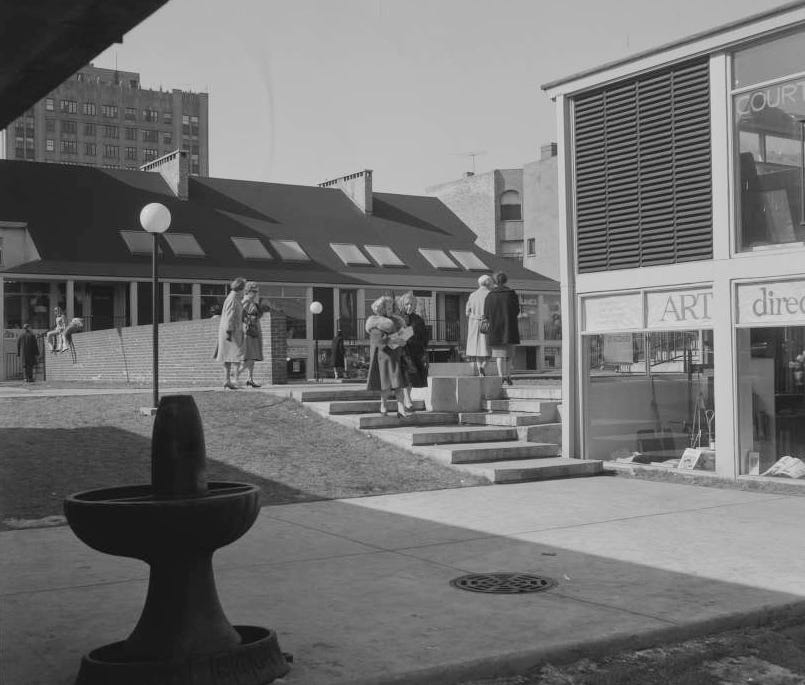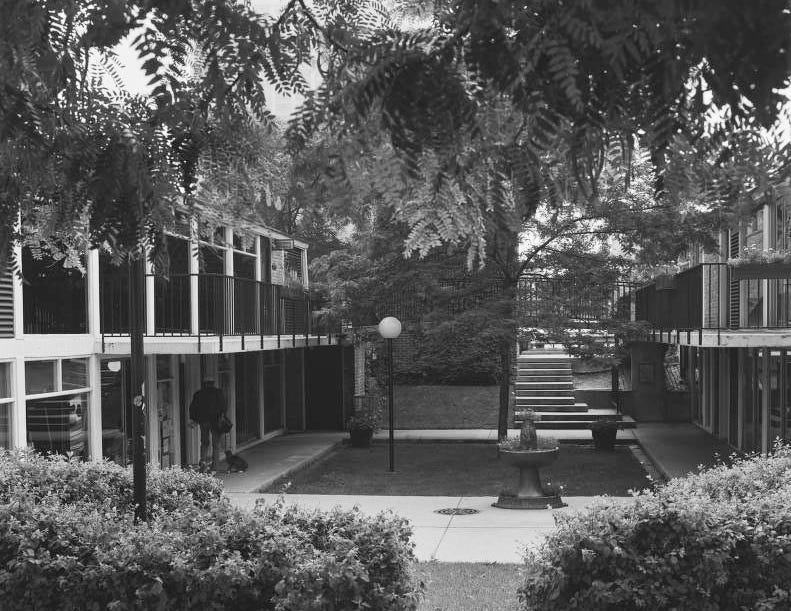I do put a lot of research into each of the articles for the Hyde Park Herald so that, within the time constraints of a monthly column, they are as accurate as possible, but some things I can’t always figure out. I’m thrilled when someone comes forward and either solves the mystery or helps sort out the probabilities. I also love when I’m looking for one thing and stumble into the answer for a completely different question—especially when that opens up a whole new rabbit hole. [edited to add in some information about William Blain and fix a date.]
Harper Court Planter
My first mystery solved was the origin of this strange planter that stood in the late lamented Harper Court. Harper Court was a complex of buildings around a sunken courtyard that was a grassroots effort to provide space for the artisans in the large ad hoc artist colony that had been wiped out by urban renewal.
While dilapidated buildings from Blackstone to Lake Park, 55th to 57th, provided cheap space for artists and writers, the most visible parts of the artist colony were the rows of concession stands built for the 1893 World’s Fair that stood east of the tracks on 57th Street. They’d been the home of writers and eccentrics since Thorstein Veblen had moved in right after the fair. It was an area where Katherine Dunham and her dance troupe felt welcome in the 1930s when the Fine Arts Building told her that Black dancers in the building were a problem and when restrictive covenants were insuring other areas of Hyde Park were White.
The whole area was one of the first earmarked for demolition. None of the planning entities—and there were many—thought about the impact. The Hyde Park Art Center petitioned to build an art space, but the land use people said no, not in the plan. They did manage to survive, but the artists fled the area as nearly 700 buildings were torn down. And of the 18 businesses in the concession stands, only 3 remained in Hyde Park two years after demolition.
By the time it dawned on neighbors that something had been lost, it was already too late. Still they tried to create a space that might be affordable for artisans. The struggle to get Harper Court off the ground took years, but the committee of neighbors kept at it, selling shares to the community. They did create a place for small shops selling art supplies, yarn, musical instruments, and plants and a space for some great restaurants. Even more so, the sunken courtyard became a genuine public square where all the various parts of Hyde Park could hang out, playing chess or eating Baskin Robbins ice cream.
There were several public statues that were part of the complex, but one was oddly abstract and plain.
Sometimes it was a planter with plants coming out of the top, bottom, and top knot.
It was in researching the cable cars that I suddenly stumbled into what it actually was. It was the memento mori of the artist colony.
It had stood at the epicenter of the studios and living quarters, on the corner of the original location of Harper Avenue and Cable Court. It was next to a building known as Coudich Castle, a four-story walkup that had housed creative people since the days of Theodore Dreiser and Vachel Lindsay.
The “artwork” was actually a cast iron Illinois Humane Society drinking fountain for dogs, horses, and humans that had been erected around 1893. Water once bubbled out the top and into the lower two pools. The fountain had been the bequest of Amabel F. Blain (1826-1892) in memory of her son. In 1990, someone at the Humane Society (no longer interested in animals) realized that they had been required to provide a plaque. So, 100 years late, one was installed. I suspect the plaque was stolen because I never noticed it.
But it was through this bookkeeping error that I discovered the story of people I’d never heard of before.
The son she wanted remembered was Franklin S. Blain, who died in 1889. In his youth, he was the village clerk of Hyde Park. Later he was the suburban correspondent for the Chicago Journal, Tribune, and Inter Ocean, when Hyde Park was a suburb. Once Hyde Park became part of Chicago, he was offered the nomination of alderman for the Citizens’ Party, but his health was already failing.
Amabel, however, had an amazing story. She came to the US from England when she was five years old. Her father had fought with Admiral Nelson in the battle of Trafalgar. Her grandfather was a cousin of Benjamin Franklin. In the 1840s, she and her husband Dr. William D. Blain had gone to California and the gold rush. By 1852, they were in Panama attempting to create some kind of colony in the jungle. When she put her foot down over the conditions, they moved to Chicago where she became a mover and shaker.
During the Civil War, she nursed the wounded and set up a support network. At one time she organized a dinner for 3,000 men. Afterward, she organized a home for disabled veterans.
By 1870, Amabel was living on her own, apparently already in Hyde Park, and Dr. Blain was out of the picture, apparently divorced. She was the president of the Hyde Park Humane Society and founded/supported the Home for Incurables (a building from it is still on Ellis Avenue), the hospital for Women and Children, and the Illinois Industrial School for Girls.
The most amazing thing, however, is that she was the perfect person to represent the arts, though no one knew it in 1990 and there was no art colony when she died in 1892. By the 1870 census, she listed her profession as “landscape painter.” As the Inter Ocean said, Amabel Blain
“followed her profession as an artist. She was one of the first women to conduct a studio in this city and old citizens will remember her atelier in Crosby Opera House before the fire. When a little girl her love of painting was so great that she used to gather berries in the woods and use the juice for coloring her pictures.”
I’m so happy that I went down this rabbit hole of history. I’m not happy that I strongly suspect that no one saved the fountain when the university bought Harper Court and tore it down. I’m going to see if I can find out more since it commemorates Amabel, Franklin, the Humane Society, the lost art colony, and the lost Harper Court.
The Unidentified Man with the Swedish King

Another mystery solved was the identity of the man in the photo with the Swedish King in my story about the Linne statue on the Midway. I love when I can name the people who mattered.
July 31, 2023
Dear editor,
Last week's Herald's story on the dedication of the Linne statue on the University's Midway included a photo of "an unidentified man" standing next to the King of Sweden. That man was my late husband Robert Ashenhurst, a long-time faculty member who was the University's longest serving Marshal. As Marshal, he was charged with ushering the King and his party around, introducing him to notables, heading the receiving line, and in general, making himself useful. In the latter category, he also helped empty out the men's room in Reynolds Club so the King could, ahem, pee in private.
Nancy Levner
I can just imagine her surprise when browsing through the Herald! Thank you, Nancy!






These are exciting discoveries indeed. Well done on uncovering the story of the fountain!
I love these histories that will never make it into a history book. I remember the fountain in Harper Court but this changes it's significance for me.